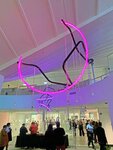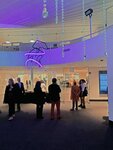Lehman College Art Gallery illuminates with chandelier-themed 'Incandescence' exhibition
The Hall of Mirrors at Versailles, a symbol of France’s opulence under the reign of Louis XIV, boasts 43 chandeliers. Lehman College’s art gallery, by contrast, features 48.
These chandeliers take center stage in the new exhibition, Incandescence, part of a triptych of parallel shows across the city, all exploring the iconography of chandeliers and its subversion.
Set to a soundtrack of light-themed songs and ambient piano by the Bronx Music Project, the months-long exhibition opened to an audience filled with the same hushed wonder one might find in children wandering through the lighting aisles of a hardware store.
In fact, some artists seemed to play into this childlike curiosity with surrealistic deconstructions that answered questions many would only dare to ask in dreams: What if a chandelier were shattered on the floor, still emitting light? What if a chandelier were made out of a turkey? Or 90 bananas?
The latter is at the lower Manhattan exhibition, but was present in conversation.
Curator Bartholomew Bland said he wanted to explore this theme for 10 years. Before landing on Incandescence, he had considered the title Light From Above.
“I think the form is really interesting,” he said, “the meaning of them, the idea of the reverential and the magisterial view. And chandeliers are very beautiful and decorative, but there’s a lot of political content.”
Bland’s role as curator — searching for visual relationships between pieces — allowed him to bring out the political undertones in chandeliers. He pointed out a chandelier shaped like a drone, cast in bronze — evoking the unsettling idea of being surveilled over dinner. This was placed in dialogue with a nearby work by Liu Bolin, a Chinese artist renowned for his Hiding in Plain Sight series, in which he camouflages himself into his surroundings to convey the government’s desire to render artists invisible.
Nearby hung two black-and-white photographs of chandeliers that Bland said were some of the most interesting pieces. Titled Fat Man and Little Boy, the chandeliers were scaled-down crystal replicas of the atomic bombs dropped on Hiroshima and Nagasaki.
“I think it’s interesting how many artists work sculpturally with chandeliers, or it pops up in their imagery, and yet they wouldn’t think of themselves as chandelier artists.” Bland said.
One such artist is Sunil Garg, who created four chandeliers for the exhibition in just three weeks. Garg, who holds a PhD in chemistry and spent years as a Wall Street lawyer, has been an artist since his youth — he had a solo show at 17 in Delhi. Though he still paints, light has become his primary medium.
Growing up on a farm outside Delhi without electricity, Garg said, “The only light we had was natural. So the idea of being able to create what I call manufactured light, to control it, to manage it and design environments around it, has always fascinated me.”
Garg’s chandeliers, hanging centrally in the gallery’s rotunda, are both a tribute to and an adaptation of their surroundings. The Lehman College art gallery was designed by famed architect Marcel Breuer, known for his iconic chairs. Each of Garg’s chandeliers incorporates the skeleton of one of Breuer’s chairs, painted a glossy black and draped with glass crystals and winding, color-changing light tubes, programmed individually.
Further complicating the iconography of chandeliers was Charlotte Westergren’s piece, Gardening #12, an “exploded cornucopia” of glass blossoms, industrial tubing and floating droplets of honey, fruit and bees. Installed over three days, Westergren’s chandelier toyed with the idea of upcycling “declasse” objects, like the glass flowers she salvaged from old middle-class household decor, playfully reinterpreting the boundaries of class and taste.
“The idea is that they’re all old, broken glass pieces and things that come from grandmas’ attics and then I breathe life into them.” she said.
In the 70s, it was common to find glass bowls filled with glass fruit in them, and Westergren managed to collect remnants of this strange trend.
While an undergraduate, Westergren had become enamored with a friend’s parents’ gigantic, classic Venetian chandelier. The family, successful architects, would change the chandelier’s decoration each season, with leaves in the autumn and flowers in the spring, which, as a young person, Westergren said she found painfully cool.
“There’s a real grandiosity to those chandeliers,” she said, “but I wanted mine to feel more organic.”
Karen Tompkins’ painting, titled “Mandala/Chandelier” was also the fruit of personal experience. The product of a stay at a country house in Hampstead Heath, she found herself looking up at a chandelier from underneath and realizing it reminded her of Tibetan buddhists’ mandalas, which held not only literal but symbolic value.
“The whole idea is that they’re trying to find the inner light,” Tompkins said, “what a chandelier is built to give. So it was this kind of mystical marriage of light.”










